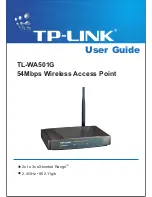
1.4 Specification
Standards
IEEE 802.3u 100BASE-TX Fast Ethernet
IEEE802.11n, IEEE 802.11g, IEEE 802.11b
Protocol CSMA/CD
Radio Technology
OFDM
Data Transfer Rate
802.11b: 1, 2, 5.5, 11Mbps
802.11g: 6, 9, 12, 18, 24, 36, 48, 54Mbps
Pre-802.11n: Up to 300Mbps
TX Power
20dBm (Max)
Power Consumption
5W (Max)
Frequency Range
2412 ~ 2484 MHz ISM band (channels 1 ~ 14)
Modulation Schemes
DBPSK/DQPSK/CCK/OFDM
Security
64/128-bits WEP Encryption; WPA, WPA-PSK
Channels
1 ~ 11 channels (FCC); 1 ~ 13 channels (ETSI);
1 ~ 14 channels (MKK)
Number of Ports
LAN: 4 x 10/100Mbps Auto-MDIX Fast Ethernet port
WAN: 1 x 10/100Mbps Auto-MDIX Fast Ethernet port
DC inputs
DC 12V 1A
Temperature
Operating: 0
°
~ 40
°
C, Storage: -10
°
~ 70
°
C
Humidity
Operating: 10% ~ 90%, Storage: 5% ~ 90%
Dimensions
153 x 173 x 64 mm (W x H x D) without Antenna
EMI:
FCC Class B, CE Mark B
1.5 Wireless Performance
The following information will help you utilizing the wireless performance, and operating coverage of
WNRT-610.
1. Site selection
To avoid interferences, please locate WNRT-610 and wireless clients away from transformers,
microwave ovens, heavy-duty motors, refrigerators, fluorescent lights, and other industrial
equipments. Keep the number of walls, or ceilings between AP and clients as few as possible;
otherwise the signal strength may be seriously reduced. Place WNRT-610 in open space or add
additional Access Point as needed to improve the coverage.
2. Environmental factors
The wireless network is easily affected by many environmental factors. Every environment is
unique with different obstacles, construction materials, weather, etc. It is hard to determine the
- 3 -
Summary of Contents for Pre-N Wireless Router WNRT-610
Page 1: ...Pre N Wireless Router WNRT 610 User s Manual...
Page 37: ...31...










































